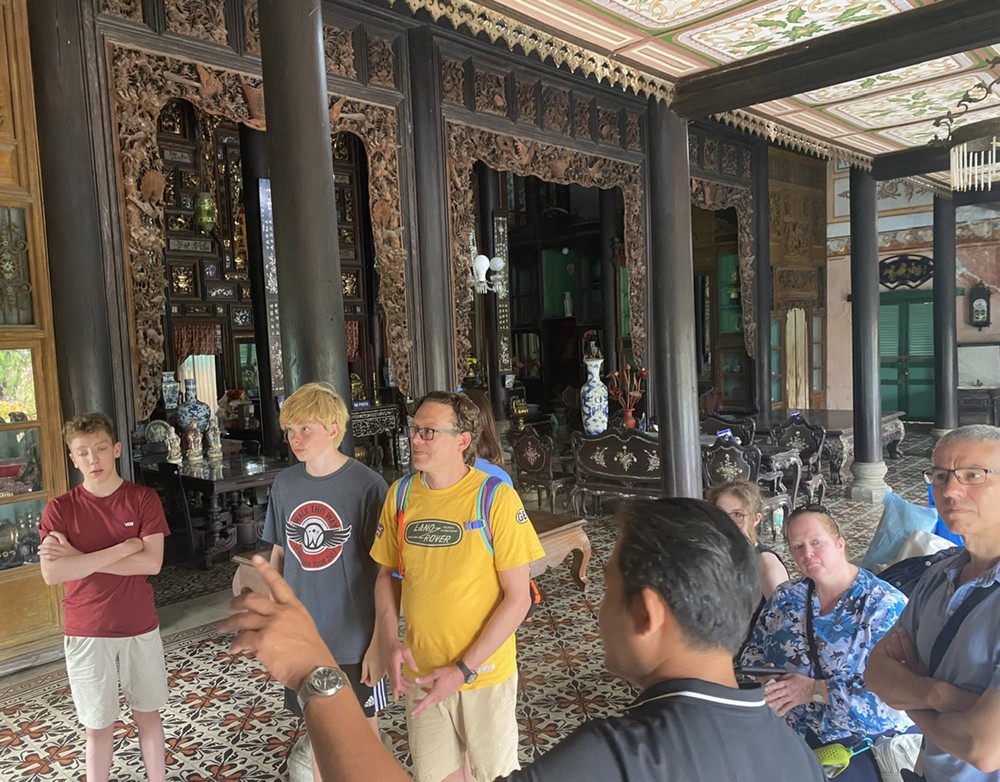
According to incomplete statistics, after 1975, the number of old houses in the Mekong Delta region was around 1,000, primarily in Tien Giang, Dong Thap, Bac Lieu, Tra Vinh provinces, and Can Tho City. However, this number has now dwindled to about two-thirds. Bac Lieu, for example, saw a decline from 21 to 17 ancient houses between 2021 and 2023.
Mr. Nham Hung, a researcher of Southern Vietnamese culture, said that preserving old houses in the Mekong Delta is very necessary as their structures carry historical significance and reflect the unique cultural imprint of the region's pioneers. The most important factor in preserving old architecture in the Mekong Delta is supporting policies and mechanisms while also finding ways to promote the value of these ancient houses.
The need to preserve these houses in order to create an identity for the region is apparent. However, the properties are possessed by individuals and controlled at the discretion of their owners. No matter how preservation is carried out, the most important thing is obtaining the owner's consent.
According to Mr. Nguyen Van Quang, Head of the Bac Lieu Provincial Heritage Management Board, the locality currently has 15 old houses that have been recognized as provincial-level relics. Over the past year, the investment, restoration, and preservation of relics have been carried out by the local government and the cultural sector, but it has not met the requirements due to a lack of funds.
For privately owned ancient houses that have not been recognized as heritage, the restoration and renovation work is even more difficult. Many old buildings are in a state of disrepair, but the owners lack the funds or the knowledge in the field of ancient house restoration. Meanwhile, the local government has not yet issued supporting policies. In some cases, property owners have declined government assistance and want to carry out repairs according to their own preferences, Mr. Quang added.
Binh Thuy ancient house in Can Tho City, owned by the Duong family for generations, was built over 150 years ago. The owner of the house is Mr. Duong Chan Ky, a wealthy merchant and landowner in the Mekong Delta. The ancient architectural building has been chosen as a filming location for many movies and has attracted a large number of tourists. However, in recent years, the number of visitors has gradually declined, partly because the house has gradually deteriorated and is covered in moss. Additionally, the disorganized management and chaotic business practices have further contributed to this issue.
According to a recent report by the Sai Gon Giai Phong (SGGP) Newspaper’s journalist, a group of about 10 British tourists visited the Binh Thuy ancient house. They were guided by an interpreter who introduced every detail of the ancient house, but like other visitors, they only spent about 15 minutes touring before leaving. Travelers were not particularly impressed with the way the house was arranged and managed by the owners. Too many objects and items in the house are arranged arbitrarily by the owner unaesthetically to attract tourists.
Planning to reduce waiting time for the start of repair
The People's Committee of Vinh Long Province recently issued Decision No. 2312/QĐ-UBND on November 11, 2024, approving the master plan for the construction of Mang Thit Brick and Pottery Kiln Area, Mang Thit District, Vinh Long Province until 2045. The scale of the planning area is about 3,060 hectares, with a population of 34,200 people by 2030 and 61,900 people by 2045. The plan aims to develop the area into a major tourist site in the province, with the goal of becoming a national tourist destination. It is expected to play a key role in strengthening economic and social development, especially tourism in the Mekong Delta region in general and Vinh Long in particular.
Director of the Department of Culture, Sports, and Tourism of Vinh Long Province, Phan Van Giau said that the total planning area is approximately 3,060 hectares, including the buffer zone and the core zone of about 330 hectares (the area with the highest concentration of kilns). Currently, in terms of land, the part owned by the people still belongs to them, and the part owned by the state remains state property. In the coming time, when the plan is implemented, businesses will negotiate with local residents. Specifically, residents can choose the form of cooperation with businesses, such as partnership, buying and selling, or joint venture. There is no relocation, no land reclamation from the people, but on-site resettlement so that people can benefit from their own land.
When the detailed plan is approved, the province calls for investment. The locality is encouraging residents to support the project, preserve their kilns, and organize tourism activities to attract tourists to learn about the tradition of making ceramic products. Additionally, the province will organize the first-ever Red Ceramic Brick-Green Economy Festival to introduce the master plan and call for investment. Mang Thit Brick and Pottery Kiln Area is a unique attraction with over 700 kilns; there is nowhere else like it in the whole country.
The planning to preserve privately owned heritage sites, such as the Mang Thit Brick and Pottery Kiln Area in Mang Thit District, Vinh Long Province, is also a solution for safeguarding private heritages. However, the immediate solution is still to reach agreements with the heritage owners.
Regarding the preservation of old villas, in June 2016, the owner of a villa dating to the French colonial era at 237 No Trang Long Street, Binh Thanh District, HCMC, began demolishing the building without obtaining approval from the People's Committee of the city. This led to a strong reaction from researchers because the house has been temporarily classified as a Group 1 villa by experts, architects, and departments that need to be preserved. Subsequently, the demolition was halted.
By October 2018, representatives of the HCMC Villa Classification Council confirmed that the city’s People’s Committee approved the demolition of the villa. The People's Committee of Binh Thanh District and the Department of Planning and Architecture reassessed the villa and determined that it belonged to Group 3, which did not require preservation. This example illustrates the complexity of planning for heritage sites that are privately owned, such as old villas, houses, or architectural structures.
























